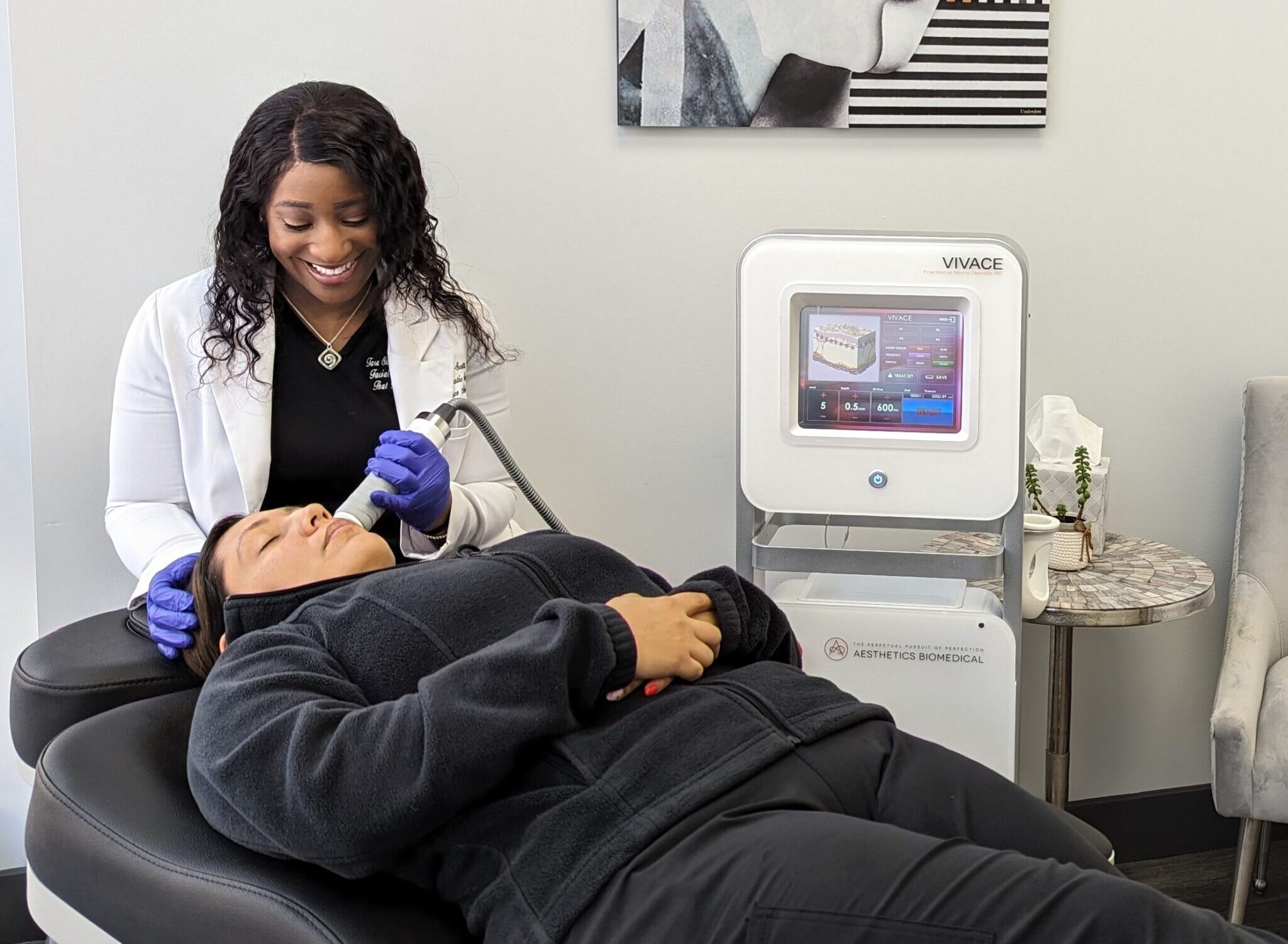Vivace® Direct – March 6th, 2024
Provider Protocols: Treating Darker Fitzpatrick Skin Types
By Dr. Omotara Sulyman-Scott of That Face Chicago
Dr. Sulyman-Scott—a former registered nurse; a trained ENT surgeon; and a fellowship-trained facial plastic surgeon—has extensive experience in caring for patients and puts compassion and empathy at the forefront of all her patient’s interactions. She is Board-Certified in Otolaryngology and Board-Eligible in Facial Plastic and Reconstructive surgery. Ethnic plastic surgery is a specialized art, Dr. Sulyman-Scott’s approach addresses ethnic features in a way that retains the natural beauty of the heritage while subtly altering facial structures to enhance and highlight the most attractive features.

Introduction
Non-surgical facial rejuvenation and skin treatments have garnered immense popularity as patients are seeking less invasive ways to regain or maintain their youthful appearance. Glowing, tight, poreless and even-toned facial skin has become all the rave across several social media platforms. As the desire for youthful flawless skin increases so has the demand for energy-based treatments. With the widespread use of energy-based devices, unwanted adverse reactions from these devices have been commonly documented and openly shared on the internet and across social media platforms. Unfortunately, patients with darker skin tones or higher Fitzpatrick skin types bear a higher burden of post-treatment adverse reactions. This has led to “skin treatment hesitation” amongst patients with darker skin tones.
The Fitzpatrick skin type classification is a description of how types of skin respond to sun exposure. This classification is mainly based on the amount of melanin present in the skin and the tendency to burn or tan when exposed to sunlight. In general, a lower Fitzpatrick skin type burns more easily than it tans, while a higher Fitzpatrick skin type tans more easily than it burns. It has been well documented that higher Fitzpatrick skin types are at higher risk of unwanted pigmentary changes and injury during treatment with energy-based devices such as lasers and microneedling with radiofrequency devices.
Radiofrequency microneedling (RFMN) is an excellent skin rejuvenation technique that causes controlled trauma to the skin by penetrating the skin with microneedles while delivering radiofrequency (heat energy) to different layers of the skin. This treatment leads to skin remodeling, stimulation of collagen and elastin production. Vivace® Microneedle RF is an FDA-cleared, innovative, effective, and safe solution for patients with higher Fitzpatrick skin types who are seeking skin rejuvenation treatments.
Understanding Fitzpatrick Skin Types

Fitzpatrick types IV-VI are considered the darker skin tones. Fitzpatrick IV skin burns minimally and tans. This skin type is often described as appearing olive or moderate brown. Fitzpatrick V rarely burns and tans easily. This skin type appears dark brown. Fitzpatrick VI never burns and always tans. This skin type appears very dark brown. This classification of skin tones may suggest certain ethnicities, but an ethnic background does not directly determine one’s Fitzpatrick skin type.
The higher Fitzpatrick skin types have a higher number of epidermal melanin and reactive fibroblasts which make these skin types less prone to photoaging but more prone to unwanted pigmentary changes (post-inflammatory hyperpigmentation), epidermal injury and scarring (hypertrophic/keloid scars) after treatment with energy-based devices. The structural and functional differences between darkly pigmented and lightly pigmented skin should be seriously considered when using energy-based devices. It is imperative that each patient’s skin type is correctly classified to appropriately tailor treatment parameters and reduce the risk of post treatment adverse events.
The Vivace® Microneedle RF Technology
Vivace® Microneedle RF uses 36 insulated, gold-tip needles and a proprietary robotic step motor to create fast, even, and minimally traumatic insertions into the skin. The chevron-pattern circuitry for the 70-watt patterned bipolar radiofrequency distributes heat evenly thus reducing redness, hot spots, burning, and discomfort. This innovative delivery of energy is particularly important when treating darker skin tones as it reduces the risk of treatment-related complications such as post-inflammatory hyperpigmentation (PIH) and scarring.
The insulation of the needles reduces excess dispersion of heat energy to the epidermal skin layer, thereby avoiding overstimulation of melanocytes which in turn reduces the risk of post-inflammatory hyperpigmentation in darker skin tones. An additional safety feature of the Vivace® Microneedle RF is the ability to change multiple treatment parameters including needle depth, power level, and pulse duration. The ability to customize the treatment parameters allows for delivery of safe and effective treatment to each individual patient.
By inducing neoelastogenesis and neocollagenesis, Vivace® Microneedle RF has been found to effectively treat myriad skin concerns in patients with higher Fitzpatrick skin types including acne scarring, and wrinkles. This device is also effective in improving skin texture, skin laxity, pore size and skin pigmentation.
Safety, Efficacy and Customizing Treatments for Darker Skin
As a Facial Plastic Surgeon and Board-Certified Otolaryngologist, my practice is focused on the treatment of the face and neck; I see patients from all the Fitzpatrick skin type classes. The most common skin concerns from my patients with darker skin tones include acne scarring, uneven skin pigmentation, large pores, and increased skin laxity. The Vivace® Microneedle RF is an excellent and safe treatment that I frequently recommend to address these concerns. Although I always recommend a series of at least three treatments (spaced four (4) to six (6) weeks apart), many of my patients begin to notice improvements in their skin after the first treatment. My patients have been very pleased with the results of their Vivace® Microneedle RF treatments.
As with any treatment, customization of the treatment parameters is important to maintain safety and efficacy of the treatment. It is imperative that treating clinicians pay attention not only to each patient’s skin type but also the skin thickness in each region of the face and treatment goal. As opposed to what some people may assume, darker skin tone does not imply increased skin thickness and avoiding this assumption will ensure appropriate depth of energy delivery during each treatment.
Vivace® Microneedle RF treatment can be tailored to address specific concerns. The main point to remember for darker skin tones is that “low and slow” promotes safety during the treatment. For acne and deep wrinkle treatments, I usually opt for a lower power level (usually at 4), long pulse duration (at 800ms) and a higher needle depth (appropriate for each patient’s skin thickness). At a lower power, there is reduced risk of PIH and scarring. The longer pulse duration allows the energy to be delivered safely over a prolonged period which allows for adequate energy to be delivered to the tissue.
| Treatment Protocol | |
| Needle Set: 36-Array | RF Time: 800ms |
| Needle Type: Insulated | Numbing Cream: Lidocaine (23%) + Tetracaine 7% |
| Frequency: 0.5 MHz | Numbing Time: 40-60 minutes |
| Depth: 2.0-2.5mm 1.5-2.5mm. depending of skin thickness and area | Passes: 2 passes with 50% overlap
Reduced depth on second pass |
| Power Level: 4 | |
Pre- and Post-Treatment Care
Guided recommendations for pre-treatment and post-treatment skin regimens are critical in ensuring optimal results and avoidance of post-treatment complications. Prior to Vivace® Microneedle RF treatment, I recommend avoidance of retinol containing products for at least one week, avoidance of excess sun exposure for two (2) weeks and avoidance of any other skin resurfacing treatment for at least four (4) weeks. I usually recommend starting a brightening serum prior to or immediately after the treatment to further reduce the risk of PIH.
After each Vivace® Microneedle RF treatment, my patients are instructed to avoid direct sunlight for one (1) to two (2) weeks and retinol containing products and harsh facial chemicals for at least one (1) week. Immediately after the Vivace™ Microneedle RF treatment, my patients are given the Vivace Experience Kit® which contains the post-treatment Soothe Mask and Boost Serum. The Boost Serum contains active tripeptides that stimulate wound healing, suppress inflammatory reaction, and inhibit skin hyperpigmentation. In addition to the Boost Serum, I recommend a medical grade moisturizer to keep the skin hydrated and daily use of broad-spectrum mineral sunscreen.
Similar to lighter skin, darker skin can also be damaged with frequent and prolonged exposure to ultraviolet rays from the sun and other environmental factors. Maintaining healthy, youthful skin requires good skin hydration, daily skin protection from ultraviolet rays and routine utilization of treatments to stimulate collagen and skin cell turnover. For my patients who have completed a series of Vivace® Microneedle RF treatments, I usually would recommend a “booster” Vivace® Microneedle RF treatment every six (6) to twelve (12) months.
Real-Life Success Stories
As a black Facial Plastic Surgeon, I have very personal experiences with dark skin tones and can easily relate to the concerns of my dark skin toned patients. With my knowledge and experience with higher Fitzpatrick types, I can guide my patients toward the most appropriate skin treatment. The majority of my dark skin toned patients openly express trust in my treatment recommendations and have been very thrilled with their results from Vivace® Microneedle RF. I see my patients after every treatment and none of my patients has reported any transient or permanent adverse reaction after their Vivace® Microneedle RF.

The patient shown in photograph A is a 55-year-old woman whose main concerns were old acne scars and increased skin laxity. Her skin type classification is a Fitzpatrick IV. She received a series of three (3) Vivace® Microneedle RF treatments to her face and neck. There were objective improvements in the visibility of her acne scars, skin texture and tightening of her facial and neck tissue. She was very happy with her results.

A second patient shown in photograph B is a 37-year-old woman who came to see me with concerns of acne scars and increased skin laxity noted. Her Fitzpatrick skin type is IV. She began her series of Vivace® Microneedle RF treatments and noted improvement in her concerns after the first treatment. Her after photos shown were after just one (1) treatment. She will be completing a series of three (3) treatments.
Conclusion
Vivace® Microneedle RF is a great skin rejuvenation procedure that has been proven to be safe and effective in treating a variety of skin concerns in patients with darker Fitzpatrick Skin. Although darker skin tones are at higher risk for unwanted pigmentary changes and scarring after energy-based treatment, the innovative technology of Vivace® Microneedle RF allows for safe delivery of energy to the desired layers of the skin to minimize the risk of adverse reactions. As a black Facial Plastic Surgeon, I would encourage individuals with darker skin tones to explore Vivace® Microneedle RF as a safe and effective treatment option for skin rejuvenation.
Note: Before undergoing any skin treatment, individuals are advised to consult with a qualified skincare professional to determine the most suitable options for their specific needs and skin type.
Get In Touch
